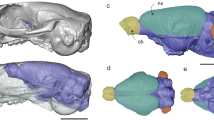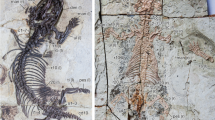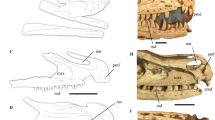Abstract
EOMYIDAE is an extinct family of rodents with a wide distribution in North America, Europe and Asia1–3. Of the modern rodent groups, eomyids are most closely related to New World pocket mice (heteromyids) and pocket gophers (geomyids)4. Eomyids occurred from the late Eocene through the Pliocene, spanning a time period of about 40 million years. From Europe alone, 11 genera and about 50 species have been recognized. The time of greatest diversity was the late Oligocene and early Miocene when eomyids dominated many small mammal faunas1,5. Their fossil record, however, consists almost exclusively of teeth, with the postcranial skeleton being virtually unknown. Here we present a complete and extraordinarily well-preserved eomyid. Its soft body outline strongly suggests the existence of gliding membranes (Figs 1, 2). Thus eomyids are the fourth family of rodents (in addition to squirrels (Sciuridae), scaly-tailed flying squirrels (Anomaluridae), and dormice (Gliridae)) with representatives capable of gliding locomotion.
This is a preview of subscription content, access via your institution
Access options
Subscribe to this journal
Receive 51 print issues and online access
$199.00 per year
only $3.90 per issue
Buy this article
- Purchase on Springer Link
- Instant access to full article PDF
Prices may be subject to local taxes which are calculated during checkout
Similar content being viewed by others
References
Engesser, B. Schweiz. Paläont. Abh. 112, 1–144 (1990).
Korth, W. W. The Tertiary Record of Rodents in North America (Plenum, New York, 1994).
Qiu, Zh.-d. Natn. Sci. Mus. Monogr., Tokyo 8, 49–55 (1994).
Fahlbusch, V. in Evolutionary Relationships among Rodents. A Multidisciplinary Analysis (ed. Luckett, P. W. & Hartenberger, J.-L.) 617–629 (Plenum, New York, 1985).
Alvarez Sierra, M. A. Scripta geol. 86, 1–207 (1987).
Comte, B. & Vianey-Liaud, M. C.r. Acad. Sci., Paris 304, 951–954 (1987).
Burbank, D. W. et al. Eclogae geol. Helv. 85, 399–431 (1992).
Wuttke, W. in Messel. An Insight into the History of Life and of the Earth (ed. Schaal, S. & Ziegler, W.) 263–275 (Clarendon, Oxford, 1992).
Emmons, L. H. & Gentry, A. H. Am. Nat. 121, 513–524 (1983).
Dudley, R. & DeVries, P. Biotropica 22, 432–434 (1990).
Thorington, R. W. & Heaney, L. R. J. Mamm. 62, 101–114 (1981).
Mein, P. & Romaggi, J.-P. Geobios 13, 45–50 (1991).
Cope, E. D. Rep. U.S. geol. Surv. Terr. 3, 1–1009 (1884).
Wood, A. E. Trans. Am. phil. Soc. 28, 155–269 (1937).
Koenigswald, W. von, Storch, G. & Richter, G. in Messel. An Insight into the History of Life and of the Earth (ed. Schaal, S. & Ziegler, W.) 217–222 (Clarendon, Oxford, 1992).
Mai, D. H. & Walther, H. Abh. Staatl. Mus. Mineral. Geol., Dresden 38, 1–230 (1991).
Author information
Authors and Affiliations
Rights and permissions
About this article
Cite this article
Storch, G., Engesser, B. & Wuttke, M. Oldest fossil record of gliding in rodents. Nature 379, 439–441 (1996). https://doi.org/10.1038/379439a0
Received:
Accepted:
Issue Date:
DOI: https://doi.org/10.1038/379439a0
This article is cited by
-
Two new cockroaches (Dictyoptera: Ectobiidae) from Rovno amber
Biologia (2023)
-
A large Eomys antiquus (Aymard, 1853) (Mammalia, Rodentia) from the early Oligocene sedimentary deposits at Bouldnor Cliff (Isle of Wight, England, UK)
Palaeobiodiversity and Palaeoenvironments (2023)
-
Differing effects of size and lifestyle on bone structure in mammals
BMC Biology (2021)
-
A bizarre Jurassic maniraptoran theropod with preserved evidence of membranous wings
Nature (2015)
-
Late Oligocene ambient temperatures reconstructed by stable isotope analysis of terrestrial and aquatic vertebrate fossils of Enspel, Germany
Palaeobiodiversity and Palaeoenvironments (2015)
Comments
By submitting a comment you agree to abide by our Terms and Community Guidelines. If you find something abusive or that does not comply with our terms or guidelines please flag it as inappropriate.



